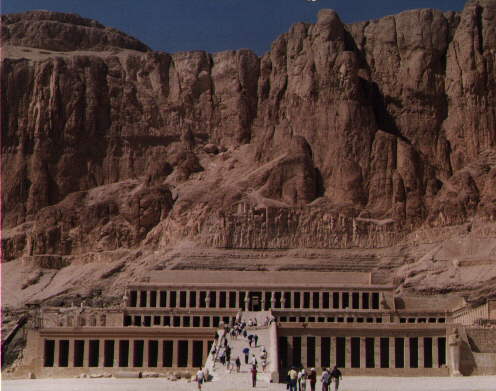
Der-el-Bahri, Mortuary Temple of Queen Hatshepsut, Dynasty 18.
EGYPT
The Nile valley with its recurrent inundations. Availability of stone. Emphasis on religion and belief in afterlife. Autocratic rule of Pharaoh, a deity-king. Strongly controlled traditions of arts and sciences. Early development of monumental architecture. Archaeological, pictorial and literary evidence.
MAP of Egypt today.
Check the British Museum pages.
More on Myths
A. Predynastic period (6000-3100 BC)
Paleolithic hunting shelters. Neolithic shelters. Use of reeds, wattle and daub. Invention of sun-dried brick. Battered clay walls. Oval and rerctangular plans. Palaces, forts and fortifications. Shrines. Importance of tombs. Development of Upper and Lower Kingdoms c. 4000 BC
B. Archaic Period (3100-2650 BC)
Dynasties 1-3 (from system recorded by Egyptian priest Manetho in 4th C BC). Unification of Upper and Lower Egypt at beginning of Dynasty 1 (Palette of Narmer). Capital at Memphis by Dynasty 3. Invention of hieroglyphs. Beginning of extensive use of stone. Mathematical systems and position of the architect. Remains of houses and palaces. Shrines, cult temples, mortuary chapels. Development of Mastaba tomb (Dyn. 1 and 2) with serekh facade, false door, offering chamber, burial chamber. Development of stepped pyramid (Dynasty 3), courts, chapels, passages, burial chamber.
Sakkara (Saqqara) Step Pyramid of Zoser (Djoser). Architect: Imhotep
C. Old Kingdom (2650-2134 BC)
Dynasties 4 to 6. Peak of royal strength during dynasty 4. Eventual decline of monarchy. Age of extensive opyramid complexes: valley temple, causeway, poyramid temple and chapels, passages, burial chamber, boat.
Pyramids of Cheops, Cheppren (Kahfre) and Mykerinos (Mykemud) at Giza (Gizeh).
First intermediate period (2134-2040 BC) Dynasties 7-10. Period of conflict among small monarchies.
D. Middle Kingdom (2040-1640 BC)
Dynasties 11-12. Rulers of Thebes united government,. Period of prosperity. Continued use of royal pyramids. Popularity of rock-cut tombs with nobility.
Beni-Hasan, Rock-cut tombs, Dynasty 12.
Second intermediate period (1640-1550 BC) Dynasties 13-17. Invasion of Hyksos from western Asia, driven out by Theban kings during Dynasty 17.
E. New Kingdom (1550-1070 BC)
Dynasties 18-20. Thebes the capital of an empire reaching from the Euphrates tp the Sudan. prosperioty, brilliance of the court, power of the priesthood of Amon. Brief reaction under Pharaoh Akhenaten (18th Dynasty). Immense cult and funerary temples. Rock-cut tombs in Valley of the KIngs near Thebes. Smallpyramis tombs for nobility. Houses, gardens, palaces. Vast temple complex that icluded: pylons, courts, obelisks, hypostile halls, sanctuaries.
Der-el-Bahri, Mortuary Temple of Queen Hatshepsut, Dynasty 18.
Karnak, Temple of Amon, Dynasties 18-19.
Tel-el Amarna, Capital underr Akhenaten, Dynasty 18.
Abu Simbel, Rock-cut Temples, Dynasty 19.
Third intermediate period ( 1070-712 BC) Dynasties 21-24
F. The Late Period (712-332 BC)
Dynasties 25 to 30. Assyrian invasion in the 7th c. BC Saitic restoration during Dynasty 26. Persian invasion in525 BC Conquest of Egypt by Alexander the Great in 332 BC
G. Graeco-Roman Period (332 BC- AD 395)
Dynasties 31 and 32. Ptolomaic Period ending with Roman occupation in 30 BC (Queen Cleopatra). Under Roman rule until division of Empire in AD 395 and under Byzantine rule until the Arab conquest in AD 641.
Last reviewed: August 2004

